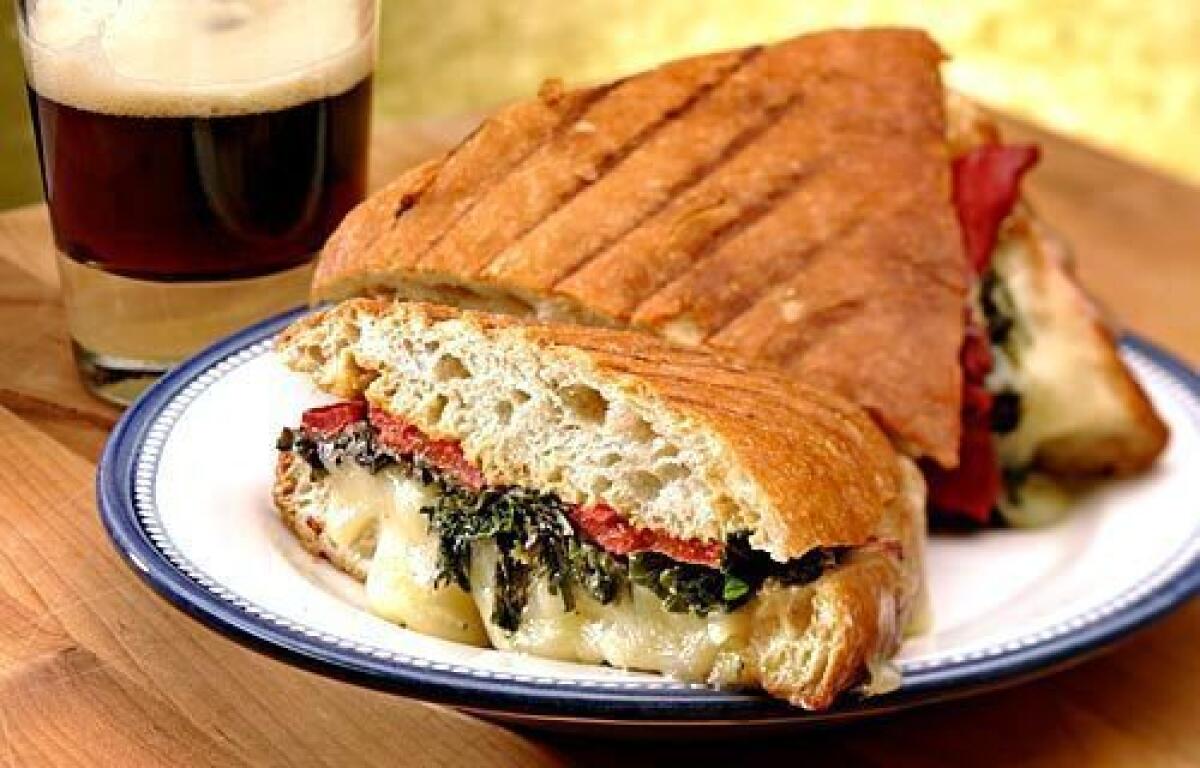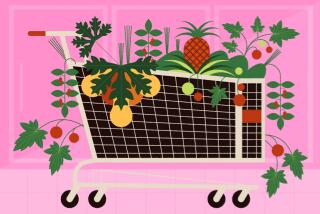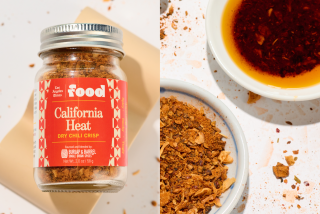Test Kitchen video tip: Roasted peppers and chiles 101

- Share via
Roasted chiles are great for adding wonderfully rich flavors and depth to a recipe, and they’re amazingly easy to prepare.
To roast peppers, place whole fresh peppers on a rack over a stove-top burner (if you’re roasting large peppers that will fit directly onto the burner grate without slipping through, you can skip the rack) and turn on the burner. Rotate the peppers over the fire using a set of tongs just until the outer skin blackens and blisters and becomes charred on all sides. Don’t leave the peppers over the burner too long or the peppers can burn.
Place the charred peppers in a paper bag or in a bowl covered with plastic wrap just until they’re cool enough to handle. After about 10 minutes, remove the charred skin by rubbing it off using a paper towel or dish rag. Never wash the peppers to remove the skin -- this will only wash off all that great roasted flavor you worked so hard to get.
If you have any kitchen tips or questions you’d like me to explore, leave a comment below or shoot me an email at [email protected].
ALSO:
Go behind the scenes at the Test Kitchen
134 recipes for your favorite restaurant dishes
Browse hundreds of recipes from the L.A. Times Test Kitchen
- See more at: https://latimesblogs.latimes.com/dailydish/2012/01/test-kitchen-tips-roasting-peppers.html#sthash.QmoeltQL.dpuf
Just like toasting ingredients can enhance the flavors of an overall dish (think spices and nuts), roasting certain ingredients -- like tomatoes, garlic or onions -- before adding them to a recipe is done to lend richness and personality to a finished dish.
Consider peppers and chiles. Added fresh to a recipe, they typically add almost fruity notes along with the heat, not to mention a crunchy texture if they’re kept raw. But roast them, and they add an almost earthy depth of flavor to the dish. Roast them yourself, and they often still have some of that crunch that you can’t find packed in jars or cans.
Best of all? Fresh-roasted peppers and chiles are so easy to prepare at home.
To roast them yourself, place whole fresh peppers or chiles on a rack over a stove-top burner (if you’re roasting large peppers that will fit directly onto the burner grate without slipping through, you can skip the rack) and turn on the burner. Rotate the peppers over the fire using a set of tongs just until the outer skin blackens and blisters and becomes charred on all sides. You’re not cooking the peppers; they should still be somewhat firm inside. Don’t leave the peppers over the burner too long or the peppers can burn.
Place the charred peppers in a paper bag or in a bowl covered with plastic wrap just until they’re cool enough to handle. After about 10 minutes, remove the charred skin by rubbing it off using a paper towel or dish rag. Never wash the peppers to remove the skin -- this will only wash off all that great roasted flavor you worked so hard to get.
If you have any kitchen tips or questions you’d like me to explore, leave a comment below or shoot me an email at [email protected].
ALSO:
Go behind the scenes at the Test Kitchen
Browse hundreds of recipes from the L.A. Times Test Kitchen
Noelle Carter on Facebook, Google+, Twitter and Pinterest. Email Noelle at [email protected].
Green panini with roasted peppers and Gruyère cheese
Total time: 25 minutes
Servings: 1
Note: Adapted from “What We Eat When We Eat Alone” by Deborah Madison and Patrick McFarlin. It is one of McFarlin’s favorites. This recipe makes more mustard greens than are used in the sandwich.
1 bunch mustard greens, stemmed and washed but not dried
1/2 cup water
Salt and pepper
1 garlic clove, pressed or minced
Red pepper flakes, a few pinches or to taste
Pepper sauce or red wine vinegar, to taste
2 pieces ciabatta, or your favorite rustic bread
Olive oil
Grated Gruyère or fontina cheese
Roasted bell pepper cut into wide strips
Dijon mustard
1. Put the mustard greens in a pot over high heat with the water that clings to the leaves plus one-half cup. Sprinkle with one-half teaspoon salt, pepper to taste, garlic and the pepper flakes and cover. After the leaves have collapsed, reduce the heat to medium and cook until they’re tender when you taste one, about 7 minutes. Drain, then squeeze the excess water out of the greens. Put them in a bowl and season with additional salt, if needed, and pepper sauce or vinegar to taste.
2. Slather the outside of the bread with olive oil. Cover one slice of the bread (the dry side) with cheese, pile on a half or a third of the greens, and add the pepper strips. Spread the top slice with Dijon mustard, then cover.
3. Cook in your panini maker or in a skillet until the bread is crispy and the cheese melts. When a wave of melted cheese hits the hot surface, there’s a bonus tang, but don’t let it burn. Slice it diagonally; it’s easier to eat that way and it looks jaunty too.
Each sandwich: 611 calories; 20 grams protein; 73 grams carbohydrates; 9 grams fiber; 27 grams fat; 6 grams saturated fat; 16 mg. cholesterol; 1,447 mg. sodium.
More to Read
Eat your way across L.A.
Get our weekly Tasting Notes newsletter for reviews, news and more.
You may occasionally receive promotional content from the Los Angeles Times.











